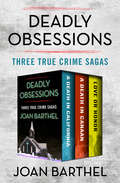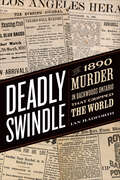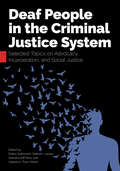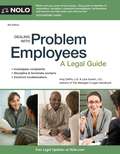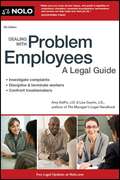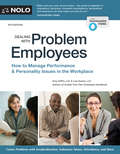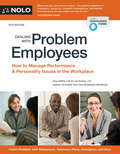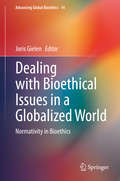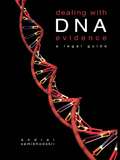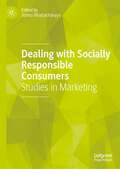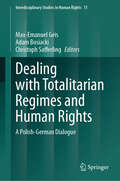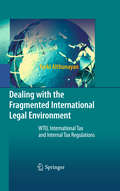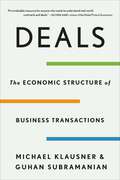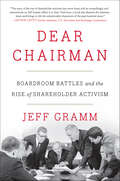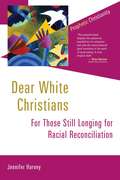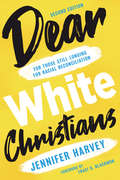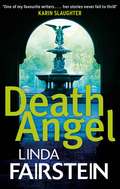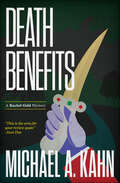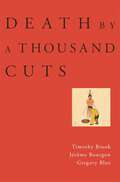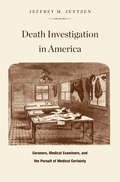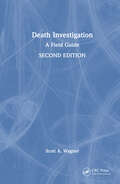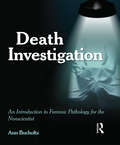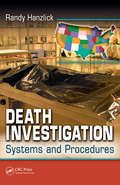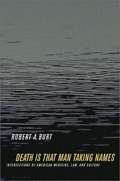- Table View
- List View
Deadly Obsessions: Three True Crime Sagas
by Joan BarthelThree true crime classics of love, murder, and the mob by a Pulitzer Prize finalist who writes with “honest and gritty realism” (Phoenix Gazette). Award-winning author Joan Barthel uncovers the dark secrets behind some of the strangest cases in the history of American crime in these three captivating works of “first-class journalism” (The New York Times). A Death in California: When twice-divorced Beverly Hills socialite Hope Masters fell in love with a handsome advertising executive, she thought her life was finally turning around—until she woke up to find a gun in her mouth and her fiancé dead in the next room. The killer was a new acquaintance who’d been visiting the couple’s Sierra Nevada ranch. Even more bizarre, however, was what happened at the end of the long, nightmarish weekend in which Masters saw everything she cared about destroyed: She began to fall in love with her tormenter. “Superbly documented, brilliantly written. The suspense will keep readers caught to the very last page” (Ann Rule, bestselling author of The Stranger Beside Me). A Death in Canaan: When eighteen-year-old Peter Reilly arrived home from the Teen Center one night to discover his mother lying naked on the bedroom floor with her throat slashed, local police made him their prime suspect. After eight hours of interrogation and a polygraph test, Reilly confessed. But the townspeople of Canaan, Connecticut, couldn’t believe the naïve teenager was capable of such a gruesome crime. With the help of some celebrities, including Mike Nichols and William Styron, the community rallied to the boy’s defense. Barthel’s “riveting” account of this fascinating and frightening case was a finalist for the Pulitzer Prize (People). Love or Honor: Police officer Chris Anastos was happily married and satisfied with his work on the NYPD’s anti-crime unit—until he was asked to go undercover to investigate links between the Italian mob and a Greek criminal network in Queens. For five years he moved back and forth between his comfortable home life and a murky, underground world of wise guys, pimps, and thieves. But when he fell in love with the beautiful, raven-haired daughter of a Long Island capo, Anastos faced his gravest threat yet. “For devotees of cop tales and mob lore . . . Tantalizing” (The New York Times Book Review).
Deadly Swindle: An 1890 Murder in Backwoods Ontario that Gripped the World (Osgoode Society for Canadian Legal History)
by Ian RadforthIn February 1890, in a remote swamp in rural southwestern Ontario, two woodsmen discovered the frozen body of a well-dressed young stranger killed by two bullets to the back of the head. Before long, police laid a murder charge on Reginald Birchall, a handsome young gentleman from London just arrived in Canada to conduct an emigration scam. Although accused of the cold-blooded murder, Birchall charmed everyone he met and delighted in the attention lavished by the press of Canada, the United States, and Britain. In Deadly Swindle, Ian Radforth tells the fascinating story of one of Canada’s most sensational murder cases and shows how the regional and international press ran with it. The book draws an intriguing picture of social life in late nineteenth-century Canada, as well as a vivid and learned portrait of the workings of the criminal justice system at this time in the country’s history. A lively narrative, Deadly Swindle is based on extensive research, notably in Victorian newspapers, and is strengthened by a thorough knowledge of press history and the legal processes of the day.
Deaf People in the Criminal Justice System: Selected Topics on Advocacy, Incarceration, and Social Justice
by Debra Guthmann Gabriel I. Lomas Damara Goff Paris Gabriel A. “Tony” MartinThe legal system is complex, and without appropriate access, many injustices can occur. Deaf people in the criminal justice system are routinely denied sign language interpreters, videophone access, and other accommodations at each stage of the legal process. The marginalization of deaf people in the criminal justice system is further exacerbated by the lack of advocates who are qualified to work with this population. Deaf People in the Criminal Justice System: Selected Topics on Advocacy, Incarceration, and Social Justice is the first book to illuminate the challenges faced by deaf people when they are arrested, incarcerated, or navigating the court system. This volume brings interdisciplinary contributors together to shed light on both the problems and solutions for deaf people in these circumstances. The contributors address issues such as accessibility needs; gaps regarding data collection and the need for more research; additional training for attorneys, court personnel, and prison staff; the need for more qualified sign language interpreters, including Certified Deaf Interpreters who provide services in court, prison, and juvenile facilities; substance use disorders; the school to prison nexus; and the need for advocacy. Students in training programs, researchers, attorneys, mental health professionals, sign language interpreters, family members, and advocates will be empowered by this much-needed resource to improve the experiences and outcomes for deaf people in the criminal justice system.
Dealing With Problem Employees
by Lisa Guerin Amy DelpoHandle workplace issues legally Are you a conscientious, well intentioned employer with a problem employee on your hands? Then this book is for you. Dealing With Problem Employees provides proven techniques and more important, immediate resolutions for how effectively manage your problem employee. Find out how to: - avoid hiring problem employees - turn problem employees into productive, valuable workers - safely and legally terminate those employees who can't or won't improve - investigate problems and complaints - conduct performance evaluations - apply progressive discipline - handle severances and references - institute effective policies and procedures This edition is completely updated to reflect the latest employment laws in your state. It also provides sample policies, forms and checklists to help you create a trouble free workplace.
Dealing With Problem Employees
by Amy Delpo AttorneyTake control of your problems and your workplace. Do you have an employee who isn't performing, isn't producing or doesn't show up at all? Or does your workplace seem to be a breeding ground for all kinds of employee problems, large and small? No matter what the problem is, this book can help. Dealing With Problem Employees provides proven techniques-- and more importantly, immediate fixes-- for dealing with the inevitable problem employee. Find out how to: avoid hiring problem employees recognize who is and isn't a problem employee help problem employees get back on track investigate problems and complaints conduct performance evaluations apply progressive discipline suspend employees fire employees handle severances and references institute effective policies and procedures The 6th edition includes the latest legal developments, including changes to the Americans with Disabilities Act and the Medical Leave Act, as well as recent Supreme Court decisions on retaliation. Information in all 50-state charts is also updated.
Dealing With Problem Employees: How to Manage Performance & Personal Issues in the Workplace
by Lisa Guerin Amy DelpoManage employee problems, legally and effectively Every workplace has occasional problems with employees. This book is packed with the legal and practical information you need to handle those problems without getting into legal trouble. It provides proven techniques—and immediate solutions. Find out how to quickly and legally: manage performance issues investigate problems and complaints help problem employees get back on track handle severances and references avoid hiring problem employees in the future This edition of Dealing With Problem Employees is completely updated to reflect the latest employment laws in every state. It provides sample policies, forms, and checklists to help you at every step.
Dealing With Problem Employees: How to Manage Performance & Personal Issues in the Workplace
by Lisa Guerin Amy DelpoManage employee problems, legally and effectively Every workplace has occasional problems with employees. This book is packed with the legal and practical information you need to handle all kinds of issues—from small corrective actions to major problems that put your company at risk. It provides proven techniques—and immediate solutions. Find out how to quickly and legally: manage performance issues investigate problems and complaints help problem employees get back on track lay the groundwork for termination handle severances and references avoid discrimination and other types of lawsuits, and avoid hiring problem employees in the future. This edition is completely updated to reflect the latest employment laws in every state. It provides sample policies, forms, and checklists to help you at every step.
Dealing with Bioethical Issues in a Globalized World: Normativity in Bioethics (Advancing Global Bioethics #14)
by Joris GielenThis book addresses the complexity of talking about normativity in bioethics within the context of contemporary multicultural and multi-religious society. It offers original contributions by specialists in bioethics exploring new ways of understanding normativity in bioethics. In bioethical publications and debates, the concept of normativity is often used without consideration of the difficulties surrounding it, whereas there are many competing claims for normativity within bioethics. Examples of such competing normative bioethical discourses can be perceived in variations and differences in bioethical arguments within individual religions, and the opposition between bioethical arguments from specific religions and arguments from bioethicists who do not claim religious allegiance. We also cannot merely assume that a Western understanding of normative bioethics will be unproblematic in bioethics in non-Western cultures and religions. Through an analysis of normativity in Christian, Hindu, Buddhist, Islamic, and Jewish bioethics, the book creates awareness of the complexity of normativity in bioethics. The book also covers normative bioethics outside an explicitly religiously committed context, and specific attention is paid to bioethics as an interdisciplinary endeavor. It reveals how normativity relates to empirical and global bioethics, which challenges it faces in bioethics in secular pluralistic society, and how to overcome these. By doing that, this book fills an important gap in bioethics literature.
Dealing with DNA Evidence: A Legal Guide
by Andrei SemikhodskiiGiving the reader an in-depth understanding of DNA evidence in criminal practice, this text explains in clear language how DNA evidence is obtained and how it can be successfully challenged in court to minimize its impact or even dismiss it completely. Since it first entered the criminal legal practice DNA has become an indispensable tool in fighting crime, as it allows both unambiguous identification of the criminal by traces of biological material left at the crime scene as well as acquitting innocent suspects. This book: outlines the various types of testing used to obtain DNA evidence highlights the weaknesses of DNA testing, presenting and discussing defence strategies for refuting DNA evidence shows how DNA should be treated as just another piece of evidence and how on its own it is often not enough to convict someone of a particular crime. This book is essential reading for students and practitioners of criminal law and practice and forensic science and law.
Dealing with Socially Responsible Consumers: Studies in Marketing
by Jishnu BhattacharyyaThis book contains a collection of teaching cases that study and emphasise how twenty-first-century businesses address and satisfy the needs and wants of socially conscious consumers while remaining profitable. This book explores the practise of marketing for societal benefit through real-life case studies. It provides a critical understanding of marketing approaches such as social marketing, sustainability marketing, and other practises of a similar nature. This book is made up of both long and short real-life cases from various industries, with varying degrees of difficulty.
Dealing with Totalitarian Regimes and Human Rights: A Polish-German Dialogue (Interdisciplinary Studies in Human Rights #11)
by Christoph Safferling Max-Emanuel Geis Adam BosiackiThis book delves into the intertwined narratives of Poland and Germany's post-war experiences, shedding light on their shared trauma from World War II and subsequent confrontations with communism. Authored by scholars from Faculty of Law and Administration, University of Warsaw and Law School of Friedrich-Alexander University Erlangen-Nuremberg, it opens a critical dialogue about the nations' efforts to recover from war, dictatorship, and human rights abuses. From constitutional law to criminal justice, the chapters explore diverse facets of their shared history, offering fresh insights and reflections. This collaborative effort culminates in a comprehensive analysis of post-war politics and legal frameworks, providing valuable perspectives on transitional justice and human rights protection. Through meticulous research and interdisciplinary discourse, the book aims to deepen Polish-German friendship, foster academic cooperation, and honor the memory of past generations while envisioning a future rooted in the rule of law, human rights, and peace for both nations and Europe as a whole. Through insightful contributions and meticulous research, it navigates complex legal and political landscapes, providing valuable insights into the challenges and opportunities inherent in navigating the legacies of war, dictatorship, and human rights abuses. It reflects on the profound implications of historical events, such as the Treaty of Versailles and the Nuremberg Trials, on legal and political landscapes. Through detailed examinations of institutional transformations and legal frameworks, it highlights the challenges of confronting past injustices and shaping future trajectories.
Dealing with the Fragmented International Legal Environment
by Turki AlthunayanTaxes are sometimes so fundamental to domestic systems that they are almost impossible to change, as when the tax system is part of a nation's majority religion or is linked to another value deeply rooted in local communities, such as housing or farming. There is a danger in the WTO, a Geneva-based entity, making decisions for people living in distant locations with regard to tax issues related to their local needs and wants. The Saudi Arabian tax system exemplifies the tension between religion, tax and trade, because tax has a role in the country's religion and is an essential part of its laws. Therefore, there is a need for maintaining a delicate balance between local needs and international commitments with respect to taxation. This book aims to show directions in which legal order can be preserved as much as possible from within each country, and yet not imposed upon them, and which will help build a peaceful bridge between local and international factors that are important to shaping the global order.
Deals: The Economic Structure of Business Transactions
by Guhan Subramanian Michael KlausnerDrawing on real-life cases from a wide range of industries, two acclaimed experts offer a sophisticated but accessible guide to business deals, designed to maximize value for your side.Business transactions take widely varying forms—from multibillion-dollar corporate mergers to patent licenses to the signing of an all-star quarterback. Yet every deal shares the same goal, or at least should: to maximize the joint value created and to distribute that value among the parties. Building on decades of experience teaching and advising on business deals, Michael Klausner and Guhan Subramanian show how to accomplish this goal through rigorous attention to designing incentives, conveying information, and specifying parties’ rights and obligations.Deals captures the range of real-life transactional complexities with case studies covering Microsoft’s acquisition of LinkedIn, Scarlett Johansson’s contract dispute with Disney over the release of Black Widow, litigation surrounding LVMH’s pandemic-disrupted acquisition of Tiffany, the feud between George Norcross and Lewis Katz over ownership of the Philadelphia Inquirer, NBC/Viacom’s negotiation with Paramount over the final three seasons of Frasier, and many more. In clear, concise terms, Klausner and Subramanian establish the basic framework of negotiation and the economic concepts that must be addressed in order to maximize value. They show how to tackle challenges, such as information asymmetry between buyer and seller, moral hazard, and opportunistic behavior. And the authors lay out responses to common risks associated with long-term contracts, emphasizing that a deal’s exit rights should be carefully considered at the start of transaction design.Unique in its practical application of economic theory to actual dealmaking, this book will be an indispensable resource for students and for professionals across the business and legal world.
Dear Chairman: Boardroom Battles and the Rise of Shareholder Activism
by Jeff GrammAn “engaging and informative” history of one of capitalism’s longest-running tensions—the high-stakes battles between management and shareholders (The New Yorker).Recent disputes between shareholders and major corporations, including Apple and DuPont, have made headlines. But the struggle between management and those who own stock has been going on for nearly a century. Mixing never-before-published and rare, original letters from Wall Street icons—including Benjamin Graham, Warren Buffett, Ross Perot, Carl Icahn, and Daniel Loeb—with masterful scholarship and professional insight, Dear Chairman traces the rise in shareholder activism from the 1920s to today, and provides an invaluable and unprecedented perspective on what it means to be a public company, including how they work and who is really in control.Jeff Gramm analyzes different eras and pivotal boardroom battles, using the letters to show how investors interact with directors and managers, how they think about their target companies, and how they plan to profit. Each is a fascinating example of capitalism at work told through the voices of its most colorful, influential participants.A hedge fund manager and adjunct professor at Columbia Business School, Gramm has seen public companies that are poorly run, and some that willfully disenfranchise their shareholders. While he pays tribute to the ingenuity of public company investors, Gramm also exposes examples of shareholder activism at its very worst, when hedge funds engineer stealthy land-grabs at the expense of a company’s long-term prospects. Ultimately, he provides a thorough, much-needed understanding of the public company/shareholder relationship for investors, managers, and everyone concerned with the future of capitalism.“An illuminating read for those wondering what drives activists.” —The Wall Street Journal“An excellent read . . . Gramm has collected a series of deliciously rich letters, many of which were never before published.” —The New York Times“The story of the rise of shareholder activism has never been told as compellingly . . . a book that dissects the dramatic deals and brings to life the unbelievable characters of the past hundred years.” —Arthur Levitt, former chairman, US Securities and Exchange Commission
Dear White Christians: For Those Still Longing for Racial Reconciliation (Prophetic Christianity Series (PC))
by Jennifer HarveyIn this provocative book Jennifer Harvey argues for a radical shift in how justice-committed white Christians think about race. She calls for moving away from the reconciliation paradigm that currently dominates interracial relations and embracing instead a reparations paradigm.Harvey presents an insightful historical analysis of the painful fissures that emerged among activist Christians toward the end of the Civil Rights movement, and she shows the necessity of bringing "white" racial identity into clear view in order to counter today's oppressive social structures.A deeply constructive, hopeful work, Dear White Christians will help readers envision new racial possibilities, including concrete examples of contemporary reparations initiatives. This book is for any who care about the gospel call to justice but feel stuck trying to get there, given the ongoing prevalence of deep racial divisions in the church and society at large.W atch a 2015 interview with the author:
Dear White Christians: For Those Still Longing for Racial Reconciliation (Prophetic Christianity Series (PC))
by Jennifer Harvey&“If reconciliation is the takeaway point for the civil rights story we usually tell, then the takeaway point for the more complex, more truthful civil rights story contained in Dear White Christians is reparations.&” — from the preface to the second editionWith the troubling and painful events of the last several years—from the killing of numerous unarmed Black men and women at the hands of police to the rallying of white supremacists in Charlottesville—it is clearer than ever that the reconciliation paradigm, long favored by white Christians, has failed to heal the deep racial wounds in the church and American society. In this provocative book, originally published in 2014, Jennifer Harvey argues for a radical shift away from the well-meaning but feeble longing for reconciliation toward a robustly biblical call for reparations. Now in its second edition—with a new preface addressing the explosive changes in American culture and politics since 2014, as well as an appendix that explores what a reparations paradigm can actually look like—Dear White Christians calls justice-committed Christians to do the gospel-inspired work of opposing racist social structures around them. Harvey&’s message is historically and scripturally rooted, making it ideal for facilitating the difficult but important discussions about race that are so desperately needed in churches and faith-centered classrooms across the country.
Death Angel (Alexandra Cooper #15)
by Linda Fairstein'Maybe she blessed the waters a century ago, but now she's a magnet for murder. She's an angel all right,' Mike said, staring at the beautiful sunlit figure that towered over us. 'A death angel.'In New York's Central Park, Assistant DA Alexandra Cooper and Detective Mike Chapman race to track down a serial killer before yet another young woman is found dead. The enormous urban park, a sanctuary in the middle of the city for thousands of New Yorkers and tourists who fill it every day, may very well become a hunting ground at night for a killer with a twisted mind . . .Once again, Linda Fairstein thrills with an explosive page-turner filled with a shocking realism that only she can deliver.
Death Benefits: A Rachel Gold Mystery (Attorney Rachel Gold Mysteries #0)
by Michael A. Kahn"A fresh-voiced heroine, down-and-dirty legal detail, and more honest detection than you'd expect make this a winner." —Kirkus ReviewsThe smart and savvy Rachel Gold has established herself in Chicago legal circles as a tough litigator, when a case calls for moxie, and a discreet counselor, when a client faces what the chairman of her former firm, Abbott & Windsor, labels an "awkward situation."The odd disappearance and messy suicide of Stoddard Anderson, the managing partner of the St. Louis office of Abbott & Windsor, certainly qualifies as an "awkward situation," especially when the firm learns that the only way Anderson's widow can collect the full life insurance proceeds is to prove that his death was an accident, and the only way a suicide can be an "accident" is if the decedent was clinically insane at the time of his death. Abbott & Windsor is, to say the least, reluctant to argue in court that the managing partner of one of its offices was clinically insane.And thus Rachel Gold is retained to represent the widow in what all hope will be a quick resolution of a straightforward matter. But Rachel soon discovers that the supposedly stodgy Stoddard Anderson was into some decidedly unstodgy activities—sexual and otherwise. Incredibly, he may have actually located Montezuma's Executor, a legendary treasure linked to a series of grisly deaths dating back to the last Aztec emperor himself. Even more incredible, Anderson may have hidden the cursed relic in St. Louis.With her best buddy, Benny Greenberg, in tow, Rachel sets off in search of both the Aztec treasure and a trail of evidence suggesting Stoddard Anderson's demise was not a suicide but a homicide. Rachel soon learns that she is not the only one in pursuit of Montezuma's Executor—and that she could be the next one to die for it!
Death By A Thousand Cuts
by Timothy Brook Gregory Blue Jérôme BourgonIn a public square in Beijing in 1904, multiple murderer Wang Weiqin was executed before a crowd of onlookers. He was among the last to suffer the extreme punishment known as lingchi. Called by Western observers “death by a thousand cuts” or “death by slicing,” this penalty was reserved for the very worst crimes in imperial China. <p><p> A unique interdisciplinary history, Death by a Thousand Cuts is the first book to explore the history, iconography, and legal contexts of Chinese tortures and executions from the tenth century until lingchi's abolition in 1905. The authors then turn their attention to an in-depth investigation of “oriental” tortures in the Western imagination. While early modern Europeans often depicted Chinese institutions as rational, nineteenth- and twentieth-century readers consumed pictures of lingchi executions as titillating curiosities and evidence of moral inferiority. By examining these works in light of European conventions associated with despotic government, Christian martyrdom, and ecstatic suffering, the authors unpack the stereotype of innate Chinese cruelty and explore the mixture of fascination and revulsion that has long characterized the West's encounter with “other” civilizations. <p> Compelling and thought-provoking, Death by a Thousand Cuts questions the logic by which states justify tormenting individuals and the varied ways by which human beings have exploited the symbolism of bodily degradation for political aims.
Death Dance (Alexandra Cooper #8)
by Linda FairsteinOnce again Linda Fairstein uses her experience as Manhattan's leading DA to create a tantalyzing web of intrigue, betrayal and murder. Teaming up with longtime friends and colleagues, Mike Chapman and Mercer Wallace, Alex Cooper investigates the disappearance of a world-famous dancer, who has vanished from the Metropolitan Opera House. Drawn behind the scenes of New York's theatrical community, the team is haunted by ghosts of the dramatic old theatres - and from their own pasts. At the same time, Alex and Mercer are trying to collar a doctor who's been using his extensive knowledge of and access to drugs to overpower women before assualting them. A spell-binding thriller combining the unique history of New York with fresh insight into the latest forensic techniques.
Death Investigation in America: Coroners, Medical Examiners, and the Pursuit of Medical Certainty
by Jeffrey M. JentzenA death occurs at home, in a hospital, on a street: why? As Jeffrey Jentzen reveals, we often never know. Why is the American system of death investigation so inconsistent and inadequate? What can the events of the assassination of President Kennedy, killing of Bobby Kennedy, and Chappaquiddick reveal about the state of death investigation? If communities in early America had a coroner at all, he was politically appointed and poorly trained. As medicine became more sophisticated and the medical profession more confident, physicians struggled to establish a professionalized, physician-led system of death investigation. The conflict between them and the coroners, as well as politicians and law enforcement agencies, led to the patchwork of local laws and practices that persist to this day. In this unique political and cultural history, Jentzen draws on archives, interviews, and his own career as a medical examiner to look at the way that a long-standing professional and political rivalry controls public medical knowledge and public health.
Death Investigation: A Field Guide
by Scott A. WagnerDeath Investigation: A Field Guide, Second Edition is updated and expanded to include a chronological analysis of the death scene investigative process from the first notification to the autopsy and final report. This book is written for the standpoints of a forensic pathologist and a forensic toxicologist emphasizing essential elements of the death investigation and how the results impact the final cause and manner of death. Topics discussed include how to assess the body at the scene and how to properly investigate natural and unnatural deaths. The book discusses various means and causes of deaths, demonstrating how death manifests in various parts of the body. A section on traumatic injuries examines and illustrates with color photographs blunt force, sharp force, gunshot wounds, and a host of other injuries that the investigator is likely to confront. Natural death conditions and disease are discussed in a separate chapter devoted to the most common manner of death. The Second Edition is fully updated with new added sections which cover forensic toxicology, statutory responsibilities, documentation and photography of the scene, DNA identification and possible contamination issues, decomposition, managing and utilizing electronic medical records, anaphylaxis and allergic reactions, infectious diseases such as Covid-19, acute peritonitis, and more. Despite including over 200 full-color photos, the book retains a succinct, handy format that is invaluable to those facing, and tasked with investigating, the reality of death on a day-to-day basis. Death Investigation: A Field Guide, Second Edition continues to serve as an invaluable resource for crime scene investigators (CSIs), coroners, medical death investigators (MDIs), and medical examiner professionals.
Death Investigation: An Introduction to Forensic Pathology for the Nonscientist
by Ann BucholtzDeath Investigation: An Introduction to Forensic Pathology for the Nonscientist provides students and law enforcement professionals with an accurate, clear overview of forensic pathology. It presents death investigation at the scene and autopsy, providing readers with a broad understanding of forensic pathology and giving them a clear picture of what happens after the examination of the scene. Readers learn what first responders should (and should not) do at the scene, and get a forensic pathologist's perspective on the importance of preserving evidence. Death Investigation methodically explains what happens during autopsy to determine cause and manner of death -- including particulars of blunt force trauma, sharp force injuries, asphyxia, and gunshot wounds -- and how findings are presented in court. Written for a criminal justice audience by a practicing forensic pathologist and educator, Death Investigation makes challenging forensics concepts accessible to nonscientists.
Death Investigation: Systems and Procedures
by Randy Hanzlick M.D.Death Investigation: Systems and Procedures is the first book dedicated to the topic of death investigation from a legal standpoint as well as the administrative and operational procedures that pertain to the medical examiner and the coroner system in the United States. Unique in its perspective, this book is the only one not concerned with instruc
Death Is That Man Taking Names: Intersections of American Medicine, Law, and Culture
by Robert A. BurtIn this profound and subtle account of psychological and social forces underlying American cultural attitudes toward death, Robert A. Burt maintains that unacknowledged ambivalence is likely to undermine the beneficent goals of post-1970s reforms and harm the very people these changes were intended to help.
